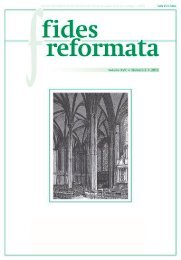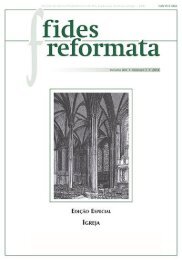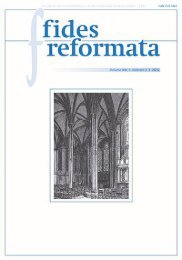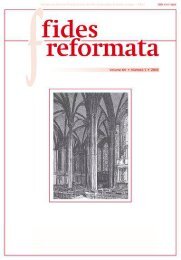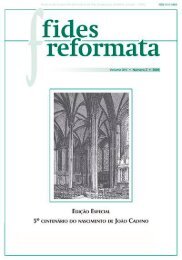Fides 18 N2 - Revista do Centro Presbiteriano Andrew Jumper
Revista Fides Reformata 18 N2 (2013)
Revista Fides Reformata 18 N2 (2013)
You also want an ePaper? Increase the reach of your titles
YUMPU automatically turns print PDFs into web optimized ePapers that Google loves.
Ralph F. Boersema, Original Righteousness<br />
to the probation and affirm that man could not have eaten of this sacrament<br />
until the probation had been passed. 8<br />
While this understanding has points in its favor, God’s command, “You<br />
may surely eat of every tree of the garden, but of the tree of the knowledge of<br />
good and evil...” (Gen 2:16-17), even reinforced in the Serpent’s dialog with<br />
Eve, suggests a different interpretation, namely one that speaks of already, but<br />
not yet. Adam already had life, but not yet its fullest expression. Eating of this<br />
tree from the beginning could have had a sacramental character of confirming<br />
present communion with God while also symbolizing greater blessings in the<br />
future. What is particularly of note is that the text makes no specific connection<br />
between the tree of life and the probation. Of course, failed probation robbed<br />
man of life, but this was true of all God’s blessings. The tree of life pointed to<br />
the eschatological prospect of higher life, but the attainment of eternal life by<br />
sinless man need not have been focused on justification, that is, the tree of life<br />
could have symbolized more than a call to lifelong obedience to the moral law.<br />
We may associate everlasting life with the symbolism of the Sabbath, a<br />
weekly rest that held out the promise of entering God’s eternal rest when man’s<br />
work would be complete (Heb 4:10). The tree of life teaches that Adam and<br />
Eve enjoyed life with God from the beginning and that the Lord was promising<br />
eternal life, more glorious fellowship with him than they already had. The<br />
Sabbath ordinance teaches that when man’s work is <strong>do</strong>ne it is granted to him<br />
to enter into God’s eternal rest. In the original order, man was called to remain<br />
righteous and to accomplish a task set before him. The task was work that was<br />
to be <strong>do</strong>ne in obedience to the Lord and righteously, but it would not make<br />
him more righteous or more justified (more accepted) than he was at creation.<br />
5. the probation<br />
When the Lord God placed man in the Garden to cultivate and conserve<br />
it, he also gave a prohibition to eat from the tree of the knowledge of good and<br />
evil (Gen 2:17). It is Scriptural to assume that Adam was to abide by God’s<br />
moral law. Surely he was not permitted to break the Sabbath, mistreat Eve or<br />
lie. Beyond the moral law, there was also the specific commandment not to eat<br />
from the tree of knowledge, giving it the character of a test. God’s testing is<br />
an important theme in the Bible (e.g., Exod 16:4; Judg 2:22; Ps 7:9; Jer 17:10;<br />
1 Pet 4:12) and Jesus, the second Adam, was also led into the wilderness for<br />
8 Cf., e.g., Geerhardus Vos, “The tree was associated with the higher, the unchangeable, the eternal<br />
life to be secured through the probation. Anticipating the result by a present enjoyment of the fruit<br />
would have been out of keeping with its sacramental character. After man should have been made sure<br />
of the attainment of the highest life, the tree would appropriately have been the sacramental means for<br />
communicating the highest life.” VOS, Geerhardus. Biblical Theology: Old and New Testaments. Grand<br />
Rapids: Eerdmans, 1948, p. 28.<br />
104







